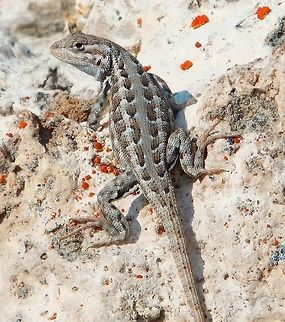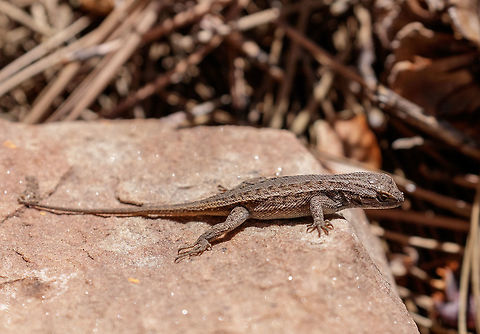
Appearance
The sagebrush lizard is usually 4.7-8.9 cm in length when fully grown. Hatchlings are about 25 mm from snout to vent in length. The lizard looks very similar to the western fence lizard, but differs in that it is typically smaller and has an increased number of scales. In appearance, the lizards are grey, brown or olive, with hints of blue or green on the dorsal surface during the light phase, and they often have irregular banding patterns on the body and tail. They also often display a black bar on the shoulder, and a light lateral and dorsolateral line on both sides. The scales on the rear portion of the thigh are small and granular, while the armpit and lateral surface of the body is often rust-colored. Females have white or yellow bellies, and males have distinctive blue patches on the abdomen and throat, although the throat patch can be absent. Males also have enlarged postanal scales, and two areas of swelling at the base of the tail. During the breeding season, males may develop orange breeding colors. Young lizards look similar to adults, but lack the dark blue markings.
Naming
The three subspecies of the sagebrush lizard, which differ in their geographic distributions, markings, and number of scales, are the northern sagebrush lizard , the western sagebrush lizard , and the southern sagebrush lizard .Distribution
This lizard’s distribution includes much of the western United States. They can be found throughout Utah, Nevada, southern Idaho, northern Arizona, northwestern New Mexico, Texas, and western Colorado. They are also widely distributed throughout areas of Wyoming, Oregon, California, and Washington. Isolated populations can be found in North Dakota and Nebraska. The lizard has been found to live at elevations ranging from 500 to 10,500 ft.Behavior
The sagebrush lizard is easily frightened and will immediately seek refuge in crevices, brush, rodent burrows, rocks, or trees when alarmed. Although in rare occasions, these lizards will stay still and play dead. Individuals bask on the ground, on low branches of bushes, and on low boulders. Mammal burrows and rock crevices may serve as hibernation sites during cold periods. Activity is almost exclusively diurnal. The length of the warm-season activity varies geographically and from year to year, but at most localities, individuals are active from March or April to late September or early October. Juveniles appear to be active later in the autumn than adults.Significant seasonal movement or migration has not been reported for this species. Lizards may occasionally move outside the normal area of activity to find suitable nest sites for egg-laying, or to find hibernation sites. Males are more active, especially in the spring, and have larger home ranges than females, although home range size is small.
The sagebrush lizard hibernates during winter weather. The duration of the inactive period varies with local climate . It is the most common lizard on Idaho sagebrush plains. In Washington, this lizard is primarily associated with sand dunes and other sandy habitats that support shrubs and have large areas of bare ground. Sagebrush lizards bask in the morning and late afternoon. Typically, they can be seen on the ground at the edge of shrubs or other vegetation that provide cover from predators. When ground temperatures become hot, they move into the low branches of shrubs or under vegetation. At night, on rainy days and on cool, butty days, they move underground or shelter under debris.
Sagebrush lizards eat a variety of insects, such as ants, beetles, grasshoppers, flies, hemipterans, and lepidopterans; they also eat arachnids. Western fence lizards are a chief food competitor with them in areas where their distributions overlap.
Habitat
True to its name, the sagebrush lizard prefers to live in sagebrush, but is also found in pine or fir forests, redwood forests, brushlands, and piñon-juniper woodlands. They can often be found sunning on logs or sedimentary rock outcroppings, and spend most of their time on the ground, although they will climb trees to escape predators.Loss of habitat due to agriculture, intensive grazing, and oil developments has affected the species in the shortgrass prairie badlands of North Dakota and other western states. Aerial spraying of insecticides may have also affected insect populations, the main diet of northern sagebrush lizards. Habitat loss has also increased with new residential developments in common habitats.
Reproduction
Males defend territories both during and after the breeding season. Territorial defense is accomplished by posturing and physical combat. Male and female territories overlap, which enables the male lizards to court and mate with a few familiar females. Courtship involves headbob and shudder displays, and is physically demanding and time-consuming. Males are usually slightly larger than females. Sagebrush lizards mate in the spring, and have one or two clutches of two to ten eggs that are laid during late spring to midsummer. The eggs are laid about 1 inch deep in loose soil, usually at the base of a shrub. The eggs hatch in 45–75 days . Females in the northwestern range may produce two clutches. The young become sexually mature in the first or second year.Predators
Sagebrush lizards are important prey for a variety of vertebrate species in the western United States. Snakes, especially striped whipsnakes and night snakes, are the main predators of the lizards, but birds of prey also consume them in large quantities. Smaller carnivorous mammals and domesticated cats also prey on them.References:
Some text fragments are auto parsed from Wikipedia.